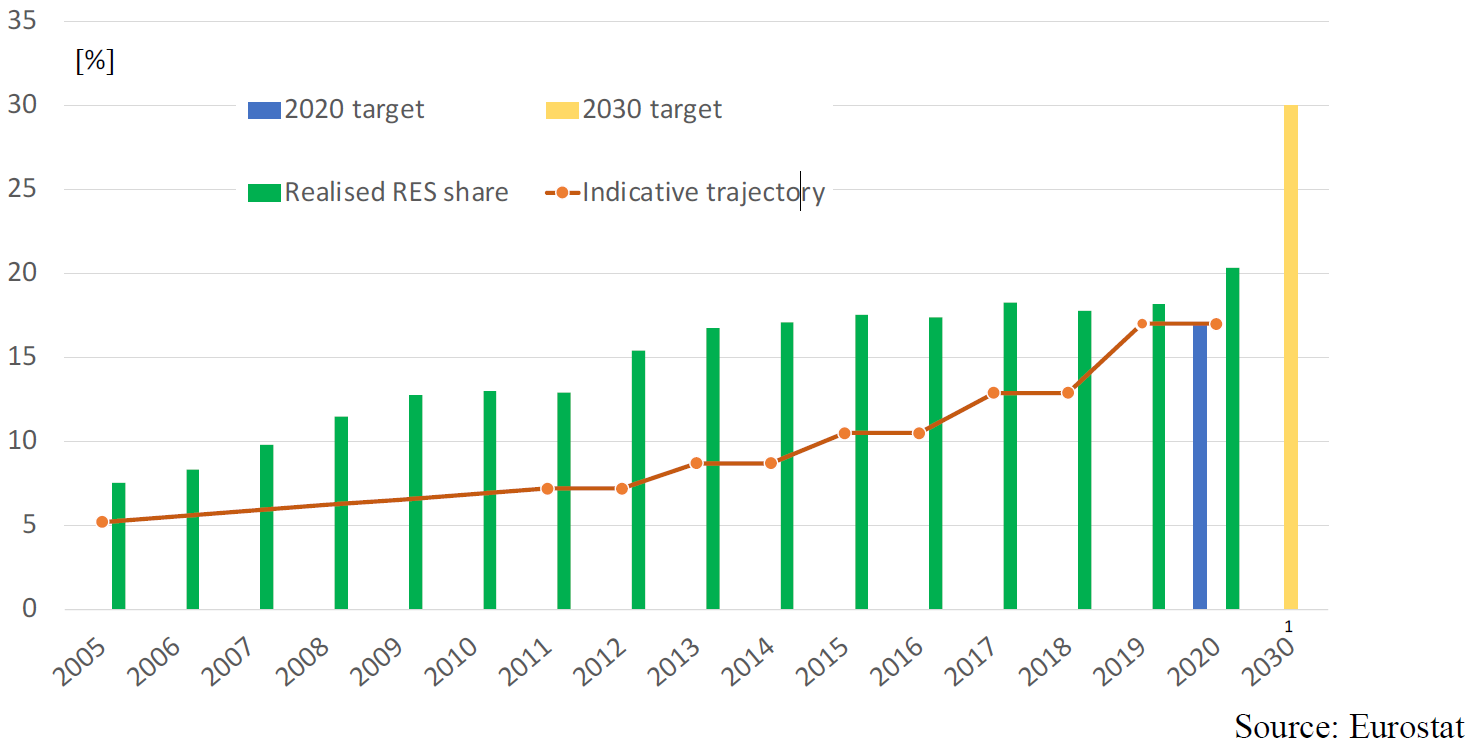Italy
Renewable Energy Status


RES- Promoting Policy Instruments

Current Renewable Energy Policy
Current Renewable Energy Policy-General
In November 2017, the National Energy Strategy (NES) is made public by the Italian government. It provides a ten-year plan and sets out the path for Italy to achieve sustainability, security and competitiveness in the national energy system.
The core targets of the NES 2017 are:
- A total of 10 Mtoe reduction in final energy consumption until 2030;
- 28% of renewables in total energy consumption by 2030;
- 55% of renewables in electricity consumption by 2030;
- Phasing out coal in electricity generation by 2025;
- Strengthening security of energy supply and narrowing the energy price gap;
- Furthering eco-friendly fuels and sustainable public mobility.
Overview of main Supporting Policies
Six years after the expiration of the main support scheme for PV power plants, the Conto Energia feed-in tariff, a new incentive scheme was introduced. On 10 August, 2019, the so-called FER1 Decree, also known as the Ministerial Decree of 4 July 2019, took effect. It grants new incentives to renewable energy sources was signed by the Italian government. The scheme provided incentives of around EUR 1 billion per year and was supposed to end in 2021. In December 2021 the Italian Legislator implemented the Directive 2018/2001/EU that extends FER1 after 2021 but also recalculate some criteria, which were criticized by some actors of the renewable industry. In addition to PV, also onshore wind, sewage gases, and hydro can benefit from the FER1 Decree. The Decree applies to RES plants that do not already receive incentives under the Ministerial Decree if 23 June 2016. The incentives are available via a reverse auction system for plants with a capacity of more than 1MWp and a ranking system for smaller plants. The FER1 decree defines timelines for completion of construction works and starting operations for projects that have been awarded a tariff under FER1.
RES - Electricity
Italy plans to increase the share of energy consumption based on renewable nergy sources within electricity consumption to at least 55 % by 2030 (38.08 % in 2020). For smaller RES installations, there is a guaranteed minimum price for electricity fed into the grid by small plants (Ritiro dedicato) and a net metering service (scambio sul posto) in place. Under the ritiro dedicato, RES producers can decide whether they sell their produced energy on the free market or alternatively to the GSE for a guaranteed minimum price, who then sells the energy on the free market. The net metering service allows the offset of electricity withdrawn from the national electricity grid and electricity a consumer/producer generates in an eligible on-site plant and injects into the grid. Furthermore, there are tax exemptions for photovoltaic and wind power plants.
RES - Heat
According to its national plan, Italy intends to reach out a 33.9 % RES share within heat and cooling consumption. With respect to RES-H, there is a tax regulation scheme as well as a guarantee fund for district heating. For small scale RES-H sources, the Conto Termico 2.0 grants incentives. Furthermore, there exists a tax detraction scheme (detrazione) for energy efficiency measures that include installing RES-H.
References & Sources for Further Reading
- CEER, Status Review of Renewable Support Schemes in Europe for 2018 and 2019 (https://www.ceer.eu/documents/104400/-/-/ffe624d4-8fbb-ff3b-7b4b-1f637f42070a)
- Dentons (2020), Italy: New incentives regime for renewable energy plants (https://www.dentons.com/en/insights/alerts/2020/december/17/fer1-decree-2019-2020-incentives-regime-for-renewable-energyplants)
- EurObserv'ER 20th annual overview barometer (https://www.eurobserv-er.org/category/all-annual-overview-barometers/)
EEA 2017: Progress of renewable energy sources, European Environmental Agency (EEA) (https://www.eea.europa.eu/data-and-maps) European Union, last accessed June 2017 - IEA database on policies and measures (https://www.iea.org/policies?qs=Italy&country%5B0%5D=Italy)
- IEA (2017), Energy Policies of IEA Countries: Italy 2016 (https://www.iea.org/reports/energy-policies-of-iea-countries-italy-2016-review)
- Italian Ministry of Economic Development (http://www.sviluppoeconomico.gov.it/index.php/en/news/2037432-national-energy-strategy)
- Gazzetta Ufficiale della Repubblica Italiana (Official Gazette of the Italian Republic), DECREE 4 July 2019 (https://www.gazzettaufficiale.it/eli/id/2019/08/09/19A05099/sg)
- Gestore Servizi Energetici (2019) (https://www.gse.it/servizi-per-te/fotovoltaico/ritiro-dedicato/regolazione-economica-del-servizio)
- Global Status Report by REN21 (http://www.ren21.net/gsr-2019/)
- Member State Progress Report, available at the Renewable Energy pages of the European
- Commission (https://energy.ec.europa.eu/topics/renewable-energy_en)
- RES Legal database: (http://www.res-legal.eu/search-by-country/Italy)
